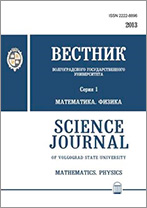|
|
Vestnik Volgogradskogo gosudarstvennogo universiteta. Seriya 1. Mathematica. Physica, 2014, Issue 1(20), Pages 6–13
(Mi vvgum10)
|
 |
|
 |
This article is cited in 1 scientific paper (total in 1 paper)
Mathematics
Continuous $HG$-deformations of surfaces with boundary in Euclidean space
A. I. Bodrenko
Volgograd State University
Abstract:
The properties of continuous deformations of surfaces with
boundary in Euclidean $3$-space preserving its Grassmannian image
and mean curvature are studied in this article.
We determine the continuous $HG$-deformation for simply connected oriented surface
$F$ with boundary $\partial F$ in Euclidean $3$-space. We derive the
differential equations of $G$-deformations of surface $F$. We
prove the lemma where we derive auxiliary properties of functions
characterizing $HG$-deformations of surface $F$.
Then on the surface $F$ we introduce conjugate isothermal
coordinate system which simplifies the form of equations of
$G$-deformations.
From the system of differential equations characterizing
$G$-deformations of surface $F$ in conjugate isothermal
coordinate system we go to the nonlinear integral equation and
resolve it by the method of successive approximations.
We derive the equations of $HG$-deformations of surface $F$. We
get the formulas of change $\Delta(g_{ij})$ and $\Delta(b_{ij})$
of coefficients $g_{ij}$ and $b_{ij}$ of the first and the second
fundamental forms of surface $F$, respectively, for deformation
$\{F_t\}$. Then, using formulas of $\Delta(g_{ij})$ and
$\Delta(b_{ij})$, we find the conditions characterizing
$HG$-deformations of two-dimensional surface $F$ in Euclidean
space $E^3$.
We show that finding of $HG$-deformations of surface $F$
brings to the following boundary-value problem $(A)$:
$$
\partial_{\overline{z}}\dot{w}+A\dot{w}+B\overline{\dot{w}}+E(\dot{w})=\dot{\Psi},
\qquad Re\{\overline{\lambda}\dot{w}\}=\dot{\varphi} \quad
\rm{on} \quad \partial F,
$$
where $A$, $B$, $\lambda$, $\dot{\Psi}$, $\dot{\varphi}$ are given
functions of complex variable, $\dot{w}$ is unknown function of
complex variable, operator $E(\dot{w})$ has implicit form.
Prior to resolving boundary-value problem $(A)$ we find the solution
of the following boundary-value problem for generalized
analytic functions:
$$\partial_{\bar{z}}\dot{w}+A\dot{w}+B\bar{\dot{w}}=\dot{\Psi},
\quad Re\{\overline{\lambda}\dot{w}\}=\dot{\varphi} \quad
\rm{on} \quad \partial F.
$$
Then we use the theory of Fredholm operator of index zero and the
theory of Volterra operator equation. Using the method of
successive approximations and the principle of contractive
mapping, we obtain solution of boundary-value problem $(A)$ and
the proof of theorem 1, the main result of this article.
Keywords:
deformation of surface, mean curvature, Gaussian curvature, $G$-deformation, continuous deformation.
Citation:
A. I. Bodrenko, “Continuous $HG$-deformations of surfaces with boundary in Euclidean space”, Vestnik Volgogradskogo gosudarstvennogo universiteta. Seriya 1. Mathematica. Physica, 2014, no. 1(20), 6–13
Linking options:
https://www.mathnet.ru/eng/vvgum10 https://www.mathnet.ru/eng/vvgum/y2014/i1/p6
|

| Statistics & downloads: |
| Abstract page: | 110 | | Full-text PDF : | 46 | | References: | 35 |
|




 Contact us:
Contact us: Terms of Use
Terms of Use
 Registration to the website
Registration to the website Logotypes
Logotypes








 Citation in format
Citation in format 
